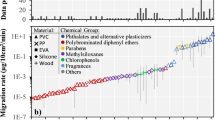Abstract
Direct measurements of exposure represent the most accurate assessment of a subject’s true exposure. The clearance of many drugs and chemicals, including pesticides such as chlorpyrifos (CPF), can be detected non-invasively in saliva. Here we have developed a serous-acinar transwell model system as an in vitro screening platform to prioritize chemicals for non-invasive biomonitoring through salivary clearance mechanisms. Rat primary serous-acinar cells express both α-amylase and aquaporin-5 proteins and develop significant tight junctions at postconfluence — a feature necessary for chemical transport studies in vitro. CPF exhibited bidirectional passage across the serous-acinar barrier that was disproportional to the passage of a cell impermeable chemical (lucifer yellow), consistent with a hypothesized passive diffusion process. CPF was metabolized to trichlorpyridinol (TCPy) by serous-acinar cells, and TCPy also displayed bidirectional diffusion in the transwell assay. This model system should prove useful as an in vitro screening platform to support the non-invasive monitoring of toxicons and pharmacons in human saliva and provide guidance for development of advanced in vitro screening platforms utilizing primary human salivary gland epithelial cells.
This is a preview of subscription content, access via your institution
Access options
Subscribe to this journal
Receive 6 print issues and online access
$259.00 per year
only $43.17 per issue
Buy this article
- Purchase on Springer Link
- Instant access to full article PDF
Prices may be subject to local taxes which are calculated during checkout




Similar content being viewed by others
Abbreviations
- AQP5:
-
aquaporin 5
- CPF:
-
chlorpyrifos
- LY:
-
lucifer yellow
- MTBSTFA:
-
N-(tert-butyldimethylsilyl)-N-methyltrifluoroacetamide
- Ω:
-
resistance
- α-amylase:
-
salivary amylase alpha
- TEER:
-
transepithelial electrical resistance
- TCPy:
-
trichlorpyridinol
- ZO-1:
-
zona occludin-1.
References
Hubal EA . Biologically relevant exposure science for 21st century toxicity testing. Toxicol Sci 2009; 111: 226–232.
Cohen Hubal EA, Richard AM, Shah I, Gallagher J, Kavlock R, Blancato J et al. Exposure science and the U.S. EPA National Center for Computational Toxicology. J Expo Sci Environ Epidemiol 2010; 20: 231–236.
Sheldon LS, Cohen Hubal EA . Exposure as part of a systems approach for assessing risk. Environ Health Perspect 2009; 117: 119–1194.
Nieuwenhuijsen M, Paustenbach D, Duarte-Davidson R . New developments in exposure assessment: the impact on the practice of health risk assessment and epidemiological studies. Environ Int 2006; 32: 996–1009.
Barr DB, Landsittel D, Nishioka M, Thomas K, Curwin B, Raymer J et al. A survey of laboratory and statistical issues related to farmworker exposure studies. Environ Health Perspect 2006; 114: 961–968.
Michalke B, Rossbach B, Goen T, Schaferhenrich A, Scherer G . Saliva as a matrix for human biomonitoring in occupational and environmental medicine. Int Arch Occup Environ Health 2015; 88: 1–44.
Alves A, Kucharska A, Erratico C, Xu F, Den Hond E, Koppen G et al. Human biomonitoring of emerging pollutants through non-invasive matrices: state of the art and future potential. Anal Bioanal Chem 2014; 406: 4063–4088.
Timchalk C, Weber TJ, Smith JN . Computational strategy for quantifying human pesticide exposure based upon a saliva measurement. Front Pharmacol 2015; 6: 115.
Martinez-Sanchez JM, Sureda X, Fu M, Perez-Ortuno R, Ballbe M, Lopez MJ et al. Secondhand smoke exposure at home: assessment by biomarkers and airborne markers. Environ Res 2014; 133: 111–116.
Timchalk C, Campbell JA, Liu G, Lin Y, Kousba AA . Development of a non-invasive biomonitoring approach to determine exposure to the organophosphorus insecticide chlorpyrifos in rat saliva. Toxicol Appl Pharmacol 2007; 219: 217–225.
Timchalk C, Poet TS, Kousba AA, Campbell JA, Lin Y . Noninvasive biomonitoring approaches to determine dosimetry and risk following acute chemical exposure: analysis of lead or organophosphate insecticide in saliva. J Toxicol Environ Health A 2004; 67: 635–650.
Begas E, Kouvaras E, Tsakalof AK, Bounitsi M, Asprodini EK . Development and validation of a reversed-phase HPLC method for CYP1A2 phenotyping by use of a caffeine metabolite ratio in saliva. Biomed Chromatogr 2015; 29: 1657–1663.
Gil F, Hernandez AF, Marquez C, Femia P, Olmedo P, Lopez-Guarnido O et al. Biomonitorization of cadmium, chromium, manganese, nickel and lead in whole blood, urine, axillary hair and saliva in an occupationally exposed population. Sci Total Environ 2011; 409: 1172–1180.
Bonanni RC, Gatto MP, Paci E, Gordiani A, Gherardi M, Tranfo G . Biomonitoring for exposure assessment to styrene in the fibreglass reinforced plastic industry: determinants and interferents. Ann Occup Hyg 2015; 59: 1000–1011.
Angerer J, Ewers U, Wilhelm M . Human biomonitoring: state of the art. Int J Hyg Environ Health 2007; 210: 201–228.
Smith JN, Wang J, Lin Y, Klohe EM, Timchalk C . Pharmacokinetics and pharmacodynamics of chlorpyrifos and 3,5,6-trichloro-2-pyridinol in rat saliva after chlorpyrifos administration. Toxicol Sci 2012; 130: 245–256.
Landon J, Mahmod S (eds). Distribution of Drugs Between Blood and Saliva. Alpha Omega Publishing Limited: Cardiff, UK. 1982, pp 47–55.
Hold KM, de Boer D, Soedirman JR, Zuidema J, Maes RA . The secretion of propranolol enantiomers in human saliva: evidence for active transport? J Pharm Biomed Anal 1995; 13: 1401–1407.
Hold KM, DeBoer D, Zuidema J, Maes RAA . Saliva as an analytical tool in toxicology. Int J Drug Testing 1995; 1: 1–36.
Smith JN, Wang J, Lin Y, Timchalk C . Pharmacokinetics of the chlorpyrifos metabolite 3,5,6-trichloro-2-pyridinol (TCPy) in rat saliva. Toxicol Sci 2010; 113: 315–325.
Haeckel R . Factors influencing the saliva/plasma ratio of drugs. Ann NY Acad Sci 1993; 694: 128–142.
Jusko WJ, Milsap RL . Pharmacokinetic principles of drug distribution in saliva. Ann NY Acad Sci 1993; 694: 36–47.
Matute-Bello G, Frevert CW, Martin TR . Animal models of acute lung injury. AmJ Physiol Lung Cell Mol Physiol 2008; 295: L379–L399.
Guo J, Zhou AW, Fu YC, Verma UN, Tripathy D, Frenkel EP et al. Efficacy of sequential treatment of HCT116 colon cancer monolayers and xenografts with docetaxel, flavopiridol, and 5-fluorouracil. Acta Pharmacol Sin 2006; 27: 1375–1381.
Weber TJ, Magnaldo T, Xiong Y . ALDH1A1 deficiency in gorlin syndrome suggests a central role for retinoic acid and ATM deficits in radiation carcinogenesis. Proteomes 2014; 2: 451–467.
Brzak KA, Harms DW, Bartels MJ, Nolan RJ . Determination of chlorpyrifos, chlorpyrifos oxon, and 3,5,6-trichloro-2-pyridinol in rat and human blood. J Anal Toxicol 1998; 22: 203–210.
Chan YH, Huang TW, Young TH, Lou PJ . Human salivary gland acinar cells spontaneously form three-dimensional structures and change the protein expression patterns. J Cell Physiol 2011; 226: 3076–3085.
Zhong Y, Zhang B, Eum SY, Toborek M . HIV-1 Tat triggers nuclear localization of ZO-1 via Rho signaling and cAMP response element-binding protein activation. J Neurosci 2012; 32: 143–150.
Ramos KS, Weber TJ. Overview of alterations in cell signaling. In: McQueen CA (ed). Comprehensive Toxicology, 2nd edn, Vol. 2. Elsevier: Kidlington, UK. 2010, pp 447–472.
Weber TJ, Chapkin RS, Davidson LA, Ramos KS . Modulation of protein kinase C-related signal transduction by 2,3,7,8-tetrachlorodibenzo-p-dioxin exhibits cell cycle dependence. Arch Biochem Biophys 1996; 328: 227–232.
Sjo A, Magnusson KE, Peterson KH . Protein kinase C activation has distinct effects on the localization, phosphorylation and detergent solubility of the claudin protein family in tight and leaky epithelial cells. J Membr Biol 2010; 236: 181–189.
Cook TJ, Shenoy SS . Intestinal permeability of chlorpyrifos using the single-pass intestinal perfusion method in the rat. Toxicology 2003; 184: 125–133.
Lassiter TL, Barone S, Jr, Moser VC, Padilla S . Gestational exposure to chlorpyrifos: dose response profiles for cholinesterase and carboxylesterase activity. Toxicol Sci 1999; 52: 92–100.
Yang J, Aschner M . Developmental aspects of blood-brain barrier (BBB) and rat brain endothelial (RBE4) cells as in vitro model for studies on chlorpyrifos transport. Neurotoxicology 2003; 24: 741–745.
Kamiyama E, Sugiyama D, Nakai D, Miura S, Okazaki O . Culture period-dependent change of function and expression of ATP-binding cassette transporters in Caco-2 cells. Drug Metab Dispos 2009; 37: 1956–1962.
Jouret F, Wu J, Hull M, Rajendran V, Mayr B, Schofl C et al. Activation of the Ca(2)+-sensing receptor induces deposition of tight junction components to the epithelial cell plasma membrane. J Cell Sci 2013; 126: 5132–5142.
Siddharthan V, Kim YV, Liu S, Kim KS . Human astrocytes/astrocyte-conditioned medium and shear stress enhance the barrier properties of human brain microvascular endothelial cells. Brain Res 2007; 1147: 39–50.
Baker OJ, Camden JM, Redman RS, Jones JE, Seye CI, Erb L et al. Proinflammatory cytokines tumor necrosis factor-alpha and interferon-gamma alter tight junction structure and function in the rat parotid gland Par-C10 cell line. Am J Physiol Cell Physiol 2008; 295: C1191–C1201.
Maria OM, Maria O, Liu Y, Komarova SV, Tran SD . Matrigel improves functional properties of human submandibular salivary gland cell line. Int J Biochem Cell Biol 2011; 43: 622–631.
Ramboer E, De Craene B, De Kock J, Vanhaecke T, Berx G, Rogiers V et al. Strategies for immortalization of primary hepatocytes. J Hepatol 2014; 61: 925–943.
Ramaiahgari SC, den Braver MW, Herpers B, Terpstra V, Commandeur JN, van de Water B et al. A 3D in vitro model of differentiated HepG2 cell spheroids with improved liver-like properties for repeated dose high-throughput toxicity studies. Arch Toxicol 2014; 88: 1083–1095.
Tirelli V, Catone T, Turco L, Di Consiglio E, Testai E, De Angelis I . Effects of the pesticide clorpyrifos on an in vitro model of intestinal barrier. Toxicol In Vitro 2007; 21: 308–313.
Sultatos LG, Basker KM, Shao M, Murphy SD . The interaction of the phosphorothioate insecticides chlorpyrifos and parathion and their oxygen analogues with bovine serum albumin. Mol Pharmacol 1984; 26: 99–104.
Acknowledgements
This work was supported by a grant from the CDC/NIOSH (RO1 OH008173-06). Chlorpyrifos and its major metabolite trichlorpyridinol (TCPy) were kindly provided by the Dow Chemical Company (Midland, MI, USA).
Author information
Authors and Affiliations
Corresponding author
Ethics declarations
Competing interests
The authors declare no conflict of interest.
Additional information
Supplementary Information accompanies the paper on the Journal of Exposure Science and Environmental Epidemiology website
Supplementary information
Rights and permissions
About this article
Cite this article
Weber, T., Smith, J., Carver, Z. et al. Non-invasive saliva human biomonitoring: development of an in vitro platform. J Expo Sci Environ Epidemiol 27, 72–77 (2017). https://doi.org/10.1038/jes.2015.74
Received:
Revised:
Accepted:
Published:
Issue Date:
DOI: https://doi.org/10.1038/jes.2015.74



